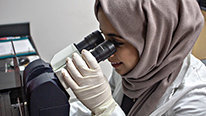
JOHN HOLCOMB
Cleveland State University
Operation STEM
NSF Awards: 1161152
2016 (see original presentation & discussion)
Undergraduate
We highlight our STEM Peer Teachers (SPTs) in action as they help students in precalculus and calculus classes complete their required mathematics classes to move forward in their STEM degree.
Mathematics, Design and Development, Broadening Participation
Cleveland State Univ
NSF Scholarships in Science, Technology, Engineering, and Mathematics Program (S-STEM)
Related Content for SPTs
-
 2021Biotechnology Associates to Masters (A2M) Degree Program
2021Biotechnology Associates to Masters (A2M) Degree Program
Elizabeth Zulick
-
 2018Not An Oxymoron: Liberal Arts Science Scholars
2018Not An Oxymoron: Liberal Arts Science Scholars
Jessica Chapman
-
 2019LEAPing from transfer student to undergraduate researcher
2019LEAPing from transfer student to undergraduate researcher
Katelyn Cooper
-
 2019ASK: Applying Scientific Knowledge
2019ASK: Applying Scientific Knowledge
Jason Deibel
-
 2018Cal-Bridge: Changing the face of STEM, one student at a time
2018Cal-Bridge: Changing the face of STEM, one student at a time
Alexander Rudolph
-
 2018S-POWER Engineering Pathways for Transfer students
2018S-POWER Engineering Pathways for Transfer students
Claire Duggan
-
 2019Living-Learning Community for Women in Computer Science
2019Living-Learning Community for Women in Computer Science
Cynthia Sanchez Gomez
-
 2020Cal-Bridge: Student Voices
2020Cal-Bridge: Student Voices
Alexander Rudolph
This video has had approximately 55 visits by 53 visitors from 17 unique locations. It has been played 33 times as of 05/2023.
Map reflects activity with this presentation from the NSF 2016 STEM For All Video Showcase website, as well as the STEM For All Multiplex website. 
Based on periodically updated Google Analytics data. This is intended to show usage trends but may not capture all activity from every visitor.
show more
Discussion from the NSF 2016 STEM For All Video Showcase (6 posts)
Colleen Lewis
Assistant Professor
How cool!!! I’m so excited to hear that you’re expanding beyond math too!
The presentation (1:48) says that as the SPTs have gotten better at their job, the students have been learning better. Is that part of the research you’re addressing within the project? How are you measuring the SPTs’ knowledge/skills/practices?
I love how the journals can help them develop their pedagogical content knowledge!
Great work!
- Colleen
John Holcomb
Professor and Chair
We simply have observed that the Precalculus students tend to do better with veteran (returning) STEM Peer Teachers (SPTs) than with the new-on-the-job SPTs. It is not part of our research at this point. Getting better at their job, and therefore, increased student performance can be attributed to numerous factors, i.e., content expertise, improved ability to explain concepts in a clearer fashion, and/or increased comfort with commanding and interacting with a roomful of peers as an undergraduate, etc. We measure the SPTs’ knowledge and skills by their grades in their own precalculus or calculus courses, faculty and peer-to-peer observations, student feedback through survey questions and SPT feedback through self-evaluations.
Barry Fishman
Professor
Great model for getting peers to lead/teach peers! How are the SPTs compensated? Are they volunteers? Do they pay for the credit hours for the additional courses they take to prepare?
This seems like a model that could work at any college.
P.s. I love the photo wall behind Susan Carver in the video – are those all the STEM Peer Teachers?
Joni Falk
You might be interested in discussing your work with presenters of
http://videohall.com/p/811 as they are exploring related issues.
Cullen White
Director
I love how you’re developing SPTs as leaders, while simultaneously providing their peers with essential supports. I’m curious about the SPT to adoptee ratio. How many students do SPTs mentor? Have you experimented with the ratio during the program’s existence?
Robert Gould
Exciting to hear students talk about learning “problem solving”!
Further posting is closed as the event has ended.